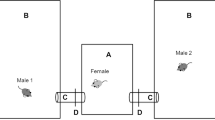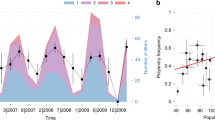Summary
Behavior of mice whose T-locus genotype was either +/+ or +/t was observed in a seminatural environment. Heterozygous females were less likely to be dominant, less likely to go into behavioral estrus, and less likely to become pregnant than were +/+ females. The relative fitness of +/t as compared with +/+ females was 0.32:1.00. In contrast, +/t males produced 35% more young than did +/+ males. The higher fitness of +/t males was primarily due to a greater production of young on the part of +/t as compared with +/+ subordinate males. Little evidence was found under these naturalistic conditions, of non-random mating with respect to T-locus genotype. The indication of overdominance for +/t males makes it unlikely that heterozygote disadvantage will be sufficient to account for the frequency of t-alleles in natural populations.
Similar content being viewed by others
References
Altmann J (1974) Observational study of behavior: sampling methods. Behaviour 49:227–267
Bateman N (1960) Selective fertilization at the T-locus of the mouse. Genet Res 1:226–238
Bennett D (1975) The T-locus of the mouse. Cell 6:441–454
Bennett D (1978) Population genetics of T/t complex mutations. In: Morse H (ed) Origins of Inbred Mice Academic Press, New York, pp 615–632
Braden AWH (1958) Influence of time of mating on segregation ratio of alleles at the T-locus in the house mouse. Nature 181:786–787
Bruck D (1957) Male segregation ratio advantage as a factor in maintaining lethal alleles in wild populations of house mice. Proc Nat Acad Sci USA 43:152–158
Cox DR (1977) Analysis of binary data. Chapman and Hall, London
Dewsbury DA (1978) The comparative method in studies in reproductive behavior. In: McGill TE, Dewsbury DA, Sachs BJ (eds) Sex and Behavior. Plenum Press, New York, pp 83–112
Dunn LC (1960) Variations in the transmission ratios of alleles through egg and sperm in Mus musculus., Am Nat 94:385–393
Dunn LC, Bennett D (1967) Maintenence of gene frequencies of a male sterile semi-lethal t-allele in a confined population of wild house mice. Am Nat 101:535–538
Dunn LC, Levene H (1961) Population dynamics of a variant t-allele in a confined population of wild house mice. Evolution 15:385–393
Dunn LC, Suckling J (1955) A preliminary comparison of the fertilities of wild house mice with and without a mutant a locus T. Am Nat 89:231–233
Dunn LC, Beasley AB, Tinker H (1958) Relative fitness of wild house mice heterozygous for a lethal allele. Am Nat 92:215–230
Egid K, Lenington S (1985) Responses of male mice to odors of females: Effects of T and H-2 locus genotype. Behav Gen 15:287–295
Franks P (1984) Dominance and reproductive success of wild house mice in a seminatural environment. Unpubl Ph D Dissertation, Rutgers University NJ
Hammerberg G, Klein J (1975) Linkage relationships of markers on chromosome 17 of the house mouse. Genet Res 26:203–211
Hartl DL (1970) A mathematical model for recessive lethal segregation distorters with differential viabilities in the sexes. Genetics 66:147–164
Ivanyi P (1978) Some aspects of the H-2 system the Major Histocompatibility System in the mouse. Proc R Soc Lond B 202:117–159
Ivanyi P, Hample R, Mickova M, Starka L (1976) The influence of the H-2 system on blood serum testosterone. Folia Biol Praha 22:42–43
Johrston PG, Brown GH (1969) A comparison of the relative fitness of genotypes segregating for the t-allele in laboratory stock and its possible effects on gene frequency in the mouse populations. Am Nat 103:5–21
Kleih J, Sipos P, Figueroa F (1984) Polymorphism of t-complex genes in European wild mice. Genet Res 44:39–46
Lacy R (1978) Dynamics of t-alleles in Mus musculus populations: Review and speculation. The Biologist 60:41–47
Larntz K (1978) Small-sample comparisons of exact levels for chi-squared goodness-of-fit statistics J Am Stat Ass 73:253–263
Lenington S (1983) Social preferences for partners carrying “good genes” in wild house mice. Anim Behav 31:325–333
Lenington S (in press) Phenotypic correlates of T-locus geno-type in wild mice: implications for evolutionary models. In: Komisaruk B, Seigal H (eds) JS Rosenblatt Festschrift
Lenington S, Egid K (1985) Female discrimination of male odors correlated with male genotype at the T-locus in Mus musculus: A response to T-locus or H-2 locus variability? Behav Genetics 15:37–51
Levene L, Rockwell RC, Grossfield J (1980) Sexual selection in mice. V. Reproductive competition between +/+ and +/tw5 males. Am Nat 116:150–156
Levin BR, Petras ML, Rassmussen DI (1969) The effect of migration on the maintenance of a lethal polymorphism in the house mouse. Am Nat 103:647–661
Lewontin RC (1962) Interdeme selection controlling a polymorphism in the house mouse. Am Nat 96:65–78
Lewontin RC (1968) The effect of differential viability on population dynamics of t-alleles in the house mouse. Evolution 22:262–273
Lewontin RC, Dunn LC (1960) The evolutionary dynamics of a polymorphism in the house mouse. Genetics 45:705–722
Martin PG, Andrewartha HG (1962) Success in fighting of two varietites of mice. Am Nat 96:375–376
Pennycuik PR, Johnston PG, Lidicker WZ, Westwood NH (1978) Introduction of a male sterile allele (tw2) into a population of house mice housed in a large outdoor enclosure. Aust J Zool 26:69–81
Petras ML (1967) Studies of natural populations of Mus II. Polymorphism at the T-locus. Evolution 21:466–478
Author information
Authors and Affiliations
Rights and permissions
About this article
Cite this article
Franks, P., Lenington, S. Dominance and reproductive behavior of wild house mice in a seminatural environment correlated with T-locus genotype. Behav Ecol Sociobiol 18, 395–404 (1986). https://doi.org/10.1007/BF00300513
Received:
Accepted:
Issue Date:
DOI: https://doi.org/10.1007/BF00300513




